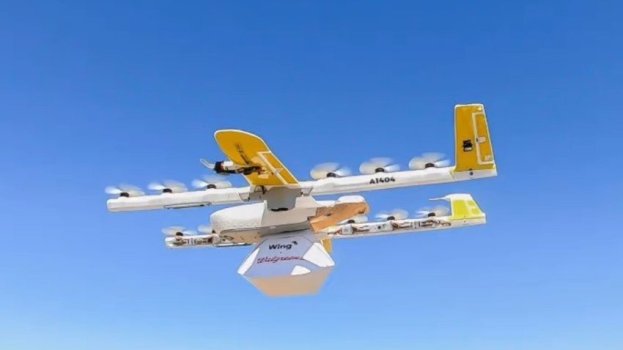K
Kathleen Martin
Guest
Walgreens and Wing Aviation tested delivery drones in Texas last year after work first began in 2019. The U.S. aviation authority will soon begin field tests for routine flights of drones beyond the visual line of sight of pilots, a capability supported by industry. (Walgreens)
Field-testing of small drone traffic management in airspace below 400 feet will begin this spring, the U.S. Federal Aviation Administration announced earlier this month. Testing is expected to last into 2023.
Test results could have a far-reaching impact on industrial users of drones. The FAA will use insights from the tests to develop new policies and help industry groups develop updated standards to allow drones to routinely fly beyond visual line of sight, or BVLOS, of their operators while also not under air traffic control.
FAA and industry partners will run multiple drone flights in realistic test scenarios to learn how to manage drone traffic in different environments. The main objective is to find ways to safely integrate drones into the national airspace.
The agency created a BVLOS Aviation rulemaking committee in June 2021 to provide recommendations for regulations for normal flights that are safe, scalable and economically viable while not under air traffic control.
Such flights are allowed today with waivers or exemptions, a spokesperson told Fierce Electronics, and the FAA has approved about 189 waivers for BVLOS operations. Drone pilots must provide a detailed risk analysis and risk-mitigation strategy. “Evaluations and approvals of waiver applications for these types of complex operations can take significant time to ensure the operation can be conducted safely,” the spokesperson added.
Industrial users of drones have been pushing for BVLOS operations for years and see the potential for GPS mapping and AI to help guide drones when out sight of operators. For example, in a disaster response scenario there might be the need to fly over an area out of the view of the operator that is hard to reach on foot. Package delivery via drone can run over longer distances with BVLOS increasing the economic benefit of such a service.
The FAA has granted Part 135 certification to allow flights by three drone air carriers, with the first granted to UPS Flight Forward in September 2019. Its first package delivery by drone was a flight of medical supplies at WakeMed Hospital in Raleigh, North Carolina.
“As the FAA works to safely integrate drones in the National Airspace System, the agency is taking a risk-based approach to assessing current regulatory requirements for proposed aircraft operations, safety, aircraft capabilities handling and impacts on airspace capacity,” the FAA spokesperson said.
“The FAA’s number one priority remains safety as drones are integrated…The FAA is encouraging innovation and working with industry, state, local and trial governments to identify the societal benefits of drones.”
Continue reading: https://www.fierceelectronics.com/electronics/faa-begin-field-tests-drones-flying-beyond-line-sight
Field-testing of small drone traffic management in airspace below 400 feet will begin this spring, the U.S. Federal Aviation Administration announced earlier this month. Testing is expected to last into 2023.
Test results could have a far-reaching impact on industrial users of drones. The FAA will use insights from the tests to develop new policies and help industry groups develop updated standards to allow drones to routinely fly beyond visual line of sight, or BVLOS, of their operators while also not under air traffic control.
FAA and industry partners will run multiple drone flights in realistic test scenarios to learn how to manage drone traffic in different environments. The main objective is to find ways to safely integrate drones into the national airspace.
The agency created a BVLOS Aviation rulemaking committee in June 2021 to provide recommendations for regulations for normal flights that are safe, scalable and economically viable while not under air traffic control.
Such flights are allowed today with waivers or exemptions, a spokesperson told Fierce Electronics, and the FAA has approved about 189 waivers for BVLOS operations. Drone pilots must provide a detailed risk analysis and risk-mitigation strategy. “Evaluations and approvals of waiver applications for these types of complex operations can take significant time to ensure the operation can be conducted safely,” the spokesperson added.
Industrial users of drones have been pushing for BVLOS operations for years and see the potential for GPS mapping and AI to help guide drones when out sight of operators. For example, in a disaster response scenario there might be the need to fly over an area out of the view of the operator that is hard to reach on foot. Package delivery via drone can run over longer distances with BVLOS increasing the economic benefit of such a service.
The FAA has granted Part 135 certification to allow flights by three drone air carriers, with the first granted to UPS Flight Forward in September 2019. Its first package delivery by drone was a flight of medical supplies at WakeMed Hospital in Raleigh, North Carolina.
“As the FAA works to safely integrate drones in the National Airspace System, the agency is taking a risk-based approach to assessing current regulatory requirements for proposed aircraft operations, safety, aircraft capabilities handling and impacts on airspace capacity,” the FAA spokesperson said.
“The FAA’s number one priority remains safety as drones are integrated…The FAA is encouraging innovation and working with industry, state, local and trial governments to identify the societal benefits of drones.”
Continue reading: https://www.fierceelectronics.com/electronics/faa-begin-field-tests-drones-flying-beyond-line-sight

